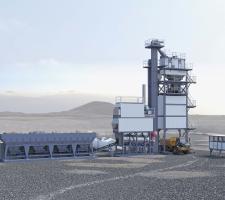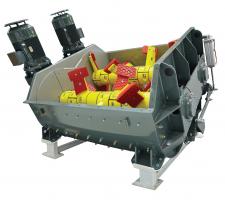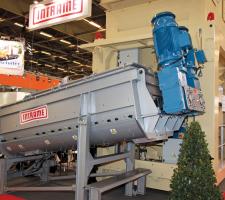
Fuel consumption, ease of movement and installation, emissions, and the use of recycled materials are today among some of the key factors for asphalt plant manufacturers.
Obviously, quality of end product is also paramount to operators, and recent developments have shown that the major producers are delivering on all counts.
For example,
Compact dimensions and high quality core components maximise performance and help to make the unit a top performer in the small asphalt mixing plant market, says Ammann.
The newly-developed plant concept features tried-and-tested Ammann technology and can be transported in standard containers, although the basic layout can be amended with additional features including cold or hot reclaimed asphalt feed, liquid or solid additives and Ammann Foam.
The plant has all the systems of a regular batch type asphalt mixing plant, while being small and compact and equipped with the latest design principles from Ammann. It also offers a host of options ranging from a basic plant to more sophisticated advanced versions. A smaller footprint makes it suitable for small level sites, whilst its ductless design eases assembly.
Maximum mixer capacity is 1.2tonnes, while the hot aggregate silo offers 16tonnes capacity and an optional hot mix storage silo offers a 50tonne capacity. Due to the compact and modular design the plant offers easy transportation, rapid assembly and commissioning due to options such as steel foundations and plug socket cabling, as well as a small footprint for use on sites with space constraints.
Easy transportation and installation are also key benefits of the new
“It’s highly mobile, and you only need one small crane for the erection. You can travel at normal road speeds,” says Martin Van Stek, sales manager with Benninghoven (part of the
The plant can be loaded on six trailers, which are built to quickly arrive at the next site.
Implemented as a group with four feed hoppers and with a loading width of 3.3m, the cold feed system can be loaded with a wheeled loader, and the unit also features a loading ramp, which is folded away for transport.
The dryer drum and burner are located on a single chassis with coordination between the two said to ensure maximum productivity and efficiency.
The entire mixing tower is set up in its working position using just one 30tonne crane. The screen, which is also situated on the chassis during transport, is placed on the hot bin section in one stroke. The hot elevator is flange-mounted to the side of the chassis and pivoted. When lifting the mixing tower, the hot elevator automatically arrives at the working position.
A mobile bitumen tank with highly efficient insulation, together with a filling and dosing pump, is supplied as standard. And the mobile command cabin with optimally positioned windows provides a panoramic view of the mixing area while the mixing processes are documented individually, enabling excellent plant statistics and cost calculation.
Meanwhile, the innovative modular Marini-Ermont RF 160 Neo continuous asphalt plant from the
The company says the plant can be transported to site by truck; is quick to erect; has low energy consumption, and can use up to 50% recycled materials in its feed.
The plant can be set up in a highly sophisticated configuration for use in Europe or used in a more basic layout for emergent market needs.
The plant, which is also said to meet the needs of contractors looking to lower carbon emissions, benefits from the company’s advanced ECOdry, ECOdrive, ECOenergy, ECOstart, ECOflame and RECYCLEAN technologies, which help to lower energy consumption.
With an output range from 80-160tonnes/hour, and incorporating the company’s Retroflux technology, featuring a counterflow dryer drum mixer, this configuration allows for the recycling of up to 50% RAP.
Fayat is also aiming its new 6tonne capacity asphalt mixer at the growing market for recycling, with the larger capacity unit well-suited to handling mixes containing recycled asphalt, according to the company.
In European plant applications a common way to use recycled asphalt pavement (RAP) is to feed the material into the mixer, but when using higher percentages of RAP, it is necessary to extend the mixing cycle. This is because the RAP gains its heat through overheating of the other aggregates, prior to spraying of the new bitumen. And this results in a longer mix time.
In the past, RAP was introduced into the mixer in contact with the overheated aggregates and new bitumen was fed into the mixer before the temperature was homogenous, says Marini.
This generated fumes containing high levels of VOC while the quality of the new bitumen was lowered due to oxidisation. High production from the plant would result in a low quality output as a result, claims the company.
But the new Marini mixer can use a feed of overheated aggregates and RAP, with its large capacity allowing sufficient time to expel the vapour while new bitumen can be injected precisely when the temperature is homogenous throughout the mix.
For example, a Marini Top Tower 4000 plant can produce around 320tonnes/hour with a conventional 45-second cycle. Increasing the mix time by 20 seconds to ensure the temperature gradient is the same across the mix when using feed combining recycled and fresh materials would cut output to 222tonnes/hour with the plant in conventional configuration. But using the 6tonne capacity mixer, maximum output of 320tonnes/hour can be achieved, while also ensuring product quality is optimised.
“It can be retrofitted to existing plants,” says Paola Pezzi, who is in charge of communications at Fayat.
“The biggest benefits to the plant are its flexibility and emissions,” says Malcolm Swanson, president of Astec (a subsidiary of Astec Industries), who points out that the plant is built on previous technology, but that it features new improvements, including a stainless steel drum and combustion flighting that withstand the higher temperatures associated with RAP.
The potential emissions reductions result from Astec’s elimination of a separate dryer for RAP, and that is significant because emissions that come from those dryers are increasingly facing scrutiny, says Swanson.
“Separate RAP dryers likely will need more pollution controls in the future. With this plant, you don’t have those emissions,” says Swanson.
Lower emissions mean that the plant will face fewer constraints with regard to getting permission from local authorities, an increasingly important issue for the asphalt sector, and this is likely to be an important selling point in the future in many markets globally, including Europe, North America and China.
Astec has beefed up its headline RAP plant from using 50% to 65% RAP content.
One of Intrame’s innovative new products is the mixer from a Flow-Mix 220 continuous asphalt plant, driven by two 30kW gearboxes, and delivered in France.
“The plant is also equipped with a special dryer, which is extended to enable high rates of recyclables. The plant has the capability of utilising up to 50% of RAP,” says Antonio Morón Hodge, general manager of Intrame.
Specialist bitumen plant manufacturer ENH has launched a mini inline emulsion plant with a capacity of 2-4tonnes/hour, which contrasts with the company’s usual size of plant which produces around 50tonnes/hour.
“It’s very mobile which means you can move it around and make the emulsion where you need it,” says Erik Haugaard, ENH managing director.
“In Scandinavia, where we are based, there are sometimes long distances between emulsion manufacturers. So instead of transporting emulsions in drums or trucks for long distances, you can move to a location where there is a hot mix plant and produce emulsions straightaway.”
Benefits of using the mini plant are that bitumen emulsion production can be cheaper, due to reduced transport costs, and more flexible. ENH has used all the technology developed in its bigger plants, of which there are currently 320 in 70 countries around the world.
“The principles are the same: there’s no difference in controlling the big one or the small one. It takes the same formulation and the same know-how,” says Haugaard.
The inline production method provides flexibility during the production phase, according to Haugaard, as the different flows for bitumen water and chemicals are controlled individually and can be changed during production without any influence on each other. There is no need to premix any chemicals or water solutions as all are added continuously during production, which means that emulsion can be produced for as long as it is required with no stoppages.
















